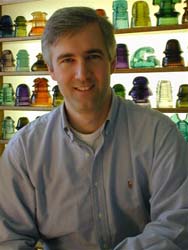
 |
David Wiecek Biography |
I have been actively
collecting insulators since 1978. I joined the National Insulator Association
(NIA) as a junior member in 1984 and have been a continuous member for the last
27 years. I
served as the Promotions and Education Committee Chair from 1995 to 1998 and
have been the Ethics Advisor since 2008.
I co-hosted the 20th National NIA convention in Allentown,
Pennsylvania (July 1989) with Frank Edgar and Doug Williams.
I still receive positive feedback to this day that this National show is
considered most memorable among collectors in terms of size, displays and
overall show experience.
I was introduced to what an
insulator was by my sixth grade teacher Mr. Siegel, who had a [CD 303] Muncie
and [CD 304] Coolie Hat that he used as paperweights for classroom assignments.
He told me he got them at a local flea market in Englishtown, New Jersey.
One of the things I distinctly remember is that he said he was approached
by people later in the day who offered to buy them from him more than he had
just paid for them. This
provided a catalyst for what became a frequent destination on Saturday and
Sunday mornings. My
best find at that flea market was a pair of complete original [CD 230.2]
Armstrong cable top insulator molds.
I only purchased one and then regrettably traded it off a few years
later.
I discovered the book “Bottles
and Relics” by Marvin and Helen Davis at my hometown library.
There were pictures of insulators in colors and shapes that I had not
previously seen photographed in natural artistic settings.
My first insulator I found was the threaded crown of a broken [CD 162]
Brookfield in emerald green that I found in an old dumping area behind the
Spotswood Reformed Church and cemetery in town.
Volume 8 (Inkwells to Lace) of the Time
Life – “The Encyclopedia of
Collectibles” series, with a section dedicated to insulators by Art
Kottman, further fueled my interest and introduced me to the book “Millholland’s
Most About Glass Insulators”, the magazine “Crown
Jewels of the Wire” and the NIA.
I was fortunate to live less
than 4 miles away from the original Old Bridge, New Jersey Brookfield factory
site and spent many days there after school in 1988 & 1989 while the area
was being transformed from a long abandoned industrial site to an apartment
complex. Among
my finds there were pieces to a French designed [CD 640] gingerbread man
insulator that is speculated to have been made by Brookfield for export to
France during World War I.
I also found a piece of a [CD 184] Climax insulator which is shown in
Brookfield catalogs. No
complete specimens of either are known to exist.
I’ve collected more or less
continuously since I was 12 years old.
I collect what I like which is colored threaded glass insulators from
North America with an emphasis on character.
The term “character”
describes what would be considered manufacturer’s defects today.
These include swirls of a second color in the glass, assorted debris in
the glass originating from the cullet it was made from, large bubbles,
deformities, interesting unintentional patterns on the glass surface and so on.
Quality control wasn’t a priority during the time most of the
insulators I collect were made.
I’ve always been drawn to the diversity of color insulators were made
in and the fact that they were originally intended as utilitarian industrial
objects and were never meant to be a collected.
I’ve been a sponsor of
Insulator Collectors on the Net (ICON) continuously since 2002.
I also have been contributing my time working on the “The
Insulator Gazette” online database since 2007 and have entered over 1300
historical articles.
I also have an interest in
deluxe balloon tire bicycles from the 1930’s – 1960’s.
I have specialized in the art deco inspired all aluminum framed Silver
King designs made by Monark in the 1930s.
Restoration work, photography and landscaping also rate highly.